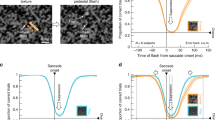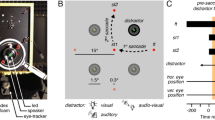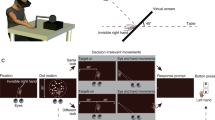Abstract
People make saccades—rapid eye movements to a new fixation—approximately three times per second. This would seemingly disrupt perceptual continuity, yet our brains construct a coherent, stable view of the world from these successive fixations. There is conflicting evidence regarding the effects of saccades on perceptual continuity: some studies report that they are disruptive, with little information carryover between saccades; others report that carryover is substantial. Here we show that saccades actively contribute to perceptual continuity in humans in two different ways. When bistable stimuli are presented intermittently, saccades executed during the blank interval shorten the duration of states of ambiguous figures, indicating that saccades can erase immediately past perceptual states. On the other hand, they prolong the McCollough effect, indicating that saccades strengthen learned contingencies. Our results indicate that saccades help, rather than hinder, perceptual continuity.
This is a preview of subscription content, access via your institution
Access options
Subscribe to this journal
Receive 12 print issues and online access
$209.00 per year
only $17.42 per issue
Buy this article
- Purchase on Springer Link
- Instant access to full article PDF
Prices may be subject to local taxes which are calculated during checkout



Similar content being viewed by others
References
Burr, D.C., Morrone, M.C. & Ross, J. Selective suppression of the magnocellular visual pathway during saccadic eye movements. Nature 371, 511–513 (1994).
Matin, L. Visual perception of direction for stimuli flashed during voluntary saccadic eye movements Science 148, 1485–1487 (1965).
Schlag, J. & Schlag-Rey, M. Illusory localization of stimuli flashed in the dark before saccades. Vision Res. 35, 709–716 (1995).
Ross, J., Morrone, M.C. & Burr, D.C. Compression of visual space before saccades. Nature 386, 598–601 (1997).
Morrone, M.C., Ross, J. & Burr, D.C. Apparent position of visual targets during real and simulated saccadic eye movements. J. Neurosci. 17, 7941–7953 (1997).
Lappe, M., Awater, H. & Krekelberg, B. Postsaccadic visual references generate presaccadic compression of space. Nature 403, 892–895 (2000).
Jonides, J., Irwin, D.E. & Yantis, S. Integrating visual information from successive fixations. Science 215, 192–194 (1982).
Hayhoe, M., Lachter, J. & Feldman, J. Integration of form across saccadic eye movements. Perception 20, 393–402 (1991).
Melcher, D. Persistence of visual memory for scenes. Nature 412, 401 (2001).
Goldberg, M.E., Bisley, J., Powell, K.D., Gottlieb, J. & Kusunoki, M. The role of the lateral intraparietal area of the monkey in the generation of saccades and visuospatial attention. Ann. NY Acad. Sci. 956, 205–215 (2002).
Moore, T. & Armstrong, K. Selective gating of visual signals by microstimulation of frontal cortex Nature 421, 370–373 (2003).
Moore, T. & Fallah, M. Control of eye movements and spatial attention. Proc. Natl. Acad. Sci. USA 98, 1273–1276 (2001).
McPeek, R.M., Maljkovic, V. & Nakayama, K. Saccades require focal attention and are facilitated by a short-term memory system. Vision Res. 39, 1555–1566 (1999).
Leopold, D.A., Wilkie, M., Maier, A. & Logothetis, N.K. Stable perception of visually ambiguous patterns. Nat. Neurosci. 5, 605–609 (2002).
Maier, A., Wilkie, M., Logothetis, N.K. & Leopold, D. Perception of temporally interleaved ambiguous patterns. Curr. Biol. 13, 1076–1085 (2003).
McCollough, C. Colour adaptation of edge-detectors in the human visual system. Science 176, 541–543 (1965).
Necker, L.A. Observations on some remarkable optical phenomena seen in Switzerland; and on an optical phenomenon which occurs on viewing a figure of a crystal or geometrical solid. Lond. Edin. Phil. Mag. J. Sci. 1, 329–337 (1832).
Dutour, E.F. Discussion d'une question d'optique. L'Academie des Sciences. Memoires de Mathematique et de physique presentes par Divers Savants 3, 514–530 (1760).
Ross, J., Badcock, D.R. & Hayes, A. Coherent global motion in the absence of coherent velocity signals. Curr. Biol. 10, 679–682 (2000).
Shute, C.C.D. The McCollough Effect (Cambridge University Press, Cambridge, 1979).
MacKay, D.M. & MacKay, V. The time course of the McCollough effect and its physiological implications. J. Physiol. 237, 38–39 (1974).
Hoffman, J.E. & Subramaniam, B. The role of visual attention in saccadic eye movements. Percept. Psychophys. 57, 787–795 (1995).
Wolf, W. Hauske, G. & Lupp, U. Interaction of pre- and post-saccadic patterns having the same co-ordinates in visual space. Vision Res. 20, 117–125 (1980).
Juttner, M. & Rohler, R. Lateral information transfer across saccadic eye movements. Percept. Psychophys. 53, 210–220 (1993).
Bridgeman, B., Hendry, D. & Stark, L. Failure to detect displacement of the visual world during saccadic eye movements. Vision Res. 15, 719–722 (1975).
Burr, D.C., Holt, J., Johnstone, J.R. & Ross, J. Selective depression of motion sensitivity during saccades J. Physiol 333, 1–15 (1982).
Goldberg, M.E. & Bruce, C.J. Primate frontal eye fields. III. Maintenance of a spatially accurate saccade signal. J. Neurophysiol. 64, 489–508 (1990).
Burr, D.C., Morrone, M.C. & Ross, J. Separate visual representations for perception and action revealed by saccadic eye movements. Curr. Biol. 11, 798–802 (2001).
Ma-Wyatt, A., Morrone, M.C. & Ross, J. A blinding flash increases saccadic compression. J. Vis. 2, 569 (2002).
Ma-Wyatt, A., Morrone, M.C. & Ross, J. Saccadic compression of visual space is significantly influenced by retinal illumination Invest. Opthamol. Vis. Sci. 44, 4105 (2003).
Duhamel, J.R., Colby, L. & Goldberg, M.E. The updating of the representation of visual space in parietal cortex by intended eye movements. Science 255, 90–92 (1992).
Krekelberg, B., Kubischik, M., Hoffmann, K.P. & Bremmer, F. Neural correlates of visual localization and perisaccadic mislocalization. Neuron 37, 537–545 (2003).
Umeno, M.M. & Goldberg, M.E. Spatial processing in the monkey frontal eye field. II. Memory responses. J. Neurophysiol. 86, 2344–2352 (2001).
Colby, C.L., Duhamel, J.R. & Goldberg, M.E. Visual, presaccadic and cognitive activation of single neurons in monkey lateral intraparietal area. J. Neurophysiol. 76, 2841–2852 (1996).
Balan, P.F. & Ferrera, V.P. Effects of gaze shifts on maintenance of spatial memory in macaque frontal eye field. J. Neurosci. 23, 5446–5454 (2003).
Thiele, A., Henning, P., Kubischik, M. & Hoffman, K.P. Neural mechanisms of saccadic suppression. Science 295, 2460–2462 (2002).
Logothetis, N.K. Single units and conscious vision. Philos. Trans. R. Soc. Lond. B Biol. Sci. 353, 1801–1818 (1998).
Lumer, E.D., Friston, K.J. & Rees, G. Neural correlates of perceptual rivalry in the human brain. Science 280, 1930–1934 (1998).
Parker, A.J., Krug, K. & Cumming, B.G. Neuronal activity and its links with the perception of multi-stable figures. Philos. Trans. R. Soc. Lond. B Biol. Sci. 357, 1053–1062 (2002).
Acknowledgements
This work was supported by the Australian Research Council. We thank S. Della Sala for alerting us to a possible connection between saccades and memory, and S. McKee and P. Verghese for helpful comments on the manuscript.
Author information
Authors and Affiliations
Corresponding author
Ethics declarations
Competing interests
The authors declare no competing financial interests.
Rights and permissions
About this article
Cite this article
Ross, J., Ma-Wyatt, A. Saccades actively maintain perceptual continuity. Nat Neurosci 7, 65–69 (2004). https://doi.org/10.1038/nn1163
Received:
Accepted:
Published:
Issue Date:
DOI: https://doi.org/10.1038/nn1163
This article is cited by
-
Eye–hand coordination while pointing rapidly under risk
Experimental Brain Research (2010)



